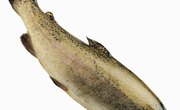
For fishermen who enjoy trout fishing, one of the best baits is made with cooked dough. Some fishing bait shops sell dough bait, either prepared or dried (that can be reconstituted), but it's easy and fun to make it yourself. You probably even have most of the items and ingredients around the house.
Prepare Cheese
You'll need to start with 2 tbsp. of shredded cheese or cheese spread. Put the cheese in a mixing bowl and heat in a microwave on high until it melts. Don't overheat the cheese or it won't mix well with the rest of the ingredients.
Mix Dry Ingredients
Mix ½ cup of all-purpose flour with 1/3 cup of granulated sugar in a large mixing bowl. Sprinkle 1 tsp. of garlic powder. Measure out one cup of water.
Combine Dry and Wet Ingredients
Combine and gradually pour half of the mixture into the bowl, stirring often. Mix in the melted cheese. Slowly pour the rest of the water, continuing to stir. The mixture will be very stiff and the dough will be dense after you finish stirring.
Cook the Dough
Fill a large pot with water and bring to a rolling boil. While you wait, pinch off marble-size hunks of dough and roll it into balls. Slowly and carefully drop the balls of dough into the boiling water, a few pieces at a time. Cook for approximately a minute and a half.
Cool the Dough Bait
Using a slotted spoon, pull the dough balls out of the water and place them on paper towels until the outsides are dry.
Substitutions and Additions
Some anglers have found that a pinch of salt or onion salt will help attract fish. An egg may be substituted for cheese. If you double the recipe, you may use one egg and 2 tbsp. of cheese. You may substitute cornmeal or finely ground grits for up to ¼ of the flour.
Store the Dough Bait
The dough bait may be stored in a sealed container or in aluminum foil. You may refrigerate it, although that's not necessary. Condensation from refrigeration is likely to soften the balls.
How to Use Dough Bait
You need to use a very small hook and place the bobber close enough to the hook so the bait floats away from the bottom. You don't want your bait to sink to the bottom, or the trout may not bite. Once the line jerks or the bobber dips, pull back and you'll most likely snag a fish.
Writer Bio
Debby Mayne started writing professionally in 1992. Her work has appeared in regional parenting magazines and she has been managing editor of the magazine, "Coping with Cancer." She was also fashion product information writer for HSN. During college, Mayne worked as an instructor at a fitness center. She holds a Bachelor of Science in health, PE and recreation from the University of Southern Mississippi.



